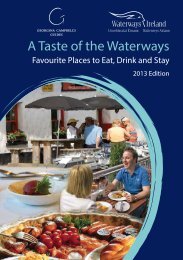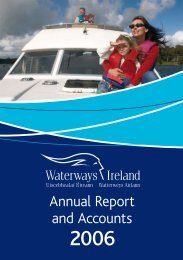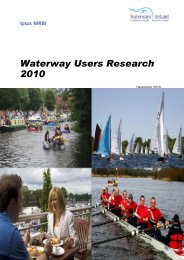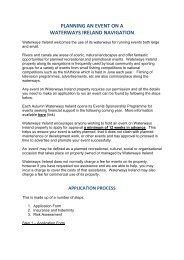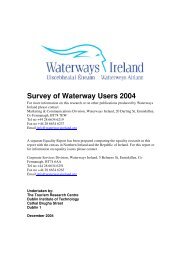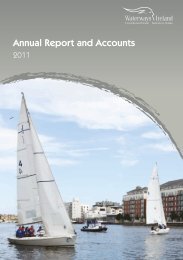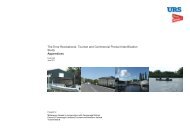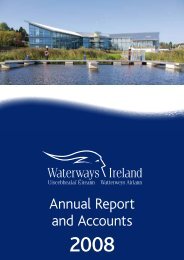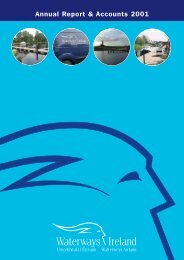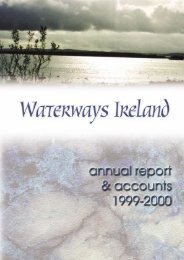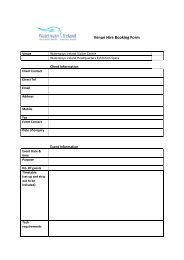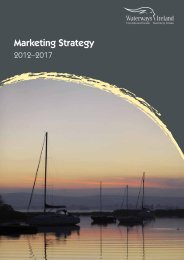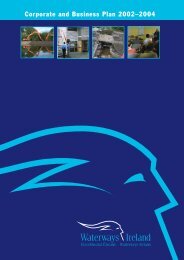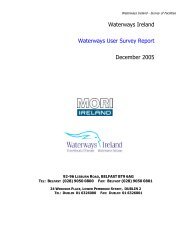Annual Accounts for the year ending 31st December 2007
Annual Accounts for the year ending 31st December 2007
Annual Accounts for the year ending 31st December 2007
Create successful ePaper yourself
Turn your PDF publications into a flip-book with our unique Google optimized e-Paper software.
Chapter 3<br />
Managing and Maintaining <strong>the</strong> Waterways<br />
In <strong>2007</strong> Waterways Ireland completed an Article 6 Assessment <strong>for</strong> a three-<strong>year</strong> strategy<br />
<strong>for</strong> maintenance activities on <strong>the</strong> River Barrow in consultation with <strong>the</strong> National Parks<br />
and Wildlife Service (NPWS), <strong>the</strong> Sou<strong>the</strong>rn Regional Fisheries Board and <strong>the</strong> Central<br />
Fisheries Board. This included field trials to assess <strong>the</strong> potential impact of <strong>the</strong> works<br />
on <strong>the</strong> protected fish species Lamprey and an aquatic plant survey to assess impacts on<br />
protected habitat consisting of floating river vegetation.<br />
Spot dredging continued on <strong>the</strong> Grand Canal following testing to ensure <strong>the</strong> spoil could<br />
be reused on site, in line with Waterways Ireland’s commitment to <strong>the</strong> sustainable reuse<br />
of natural resources which prevents <strong>the</strong> unnecessary use of landfills. In ongoing ef<strong>for</strong>ts<br />
to ensure <strong>the</strong> conservation of biodiversity in <strong>the</strong> canals, Waterways Ireland transplanted<br />
specimens of Groenlandia densa (a rare and protected aquatic plant) to <strong>the</strong> Botanic<br />
Gardens in agreement with NPWS. Waterways Ireland is also co-funding an assessment<br />
of Myxas glutinosa a rare species of snail found on <strong>the</strong> Grand Canal to assess potential<br />
mitigation measures to ensure its conservation.<br />
On <strong>the</strong> Erne System environmental scoping exercises were completed <strong>for</strong> replacement<br />
moorings at Geaglum in Upper Lough Erne, which also required an Article 6 Assessment,<br />
and at <strong>the</strong> Round O in Enniskillen.<br />
To facilitate <strong>the</strong> conservation and management of <strong>the</strong> waterways as resources of<br />
regional and international heritage significance, Waterways Ireland commenced <strong>the</strong><br />
development of inventories of heritage structures in <strong>2007</strong> along <strong>the</strong> Shannon-Erne<br />
Waterway, <strong>the</strong> Royal Canal, <strong>the</strong> Grand Canal and <strong>the</strong> River Barrow. These inventories<br />
include architectural, engineering and industrial heritage and were conducted to<br />
ensure that all heritage requirements are incorporated into <strong>the</strong> design, construction<br />
and maintenance phases of Waterways Ireland’s projects. They will also facilitate an<br />
assessment of conservation requirements to ensure <strong>the</strong> waterways’ distinctive heritage<br />
values are conserved and to safeguard <strong>the</strong>ir potential <strong>for</strong> future use and development.<br />
Waterways Ireland also commissioned an underwater archaeological survey of <strong>the</strong> weir<br />
in Killaloe on <strong>the</strong> Shannon Navigation and a terrestrial geophysical survey at a site in<br />
Monasterevin on <strong>the</strong> Grand Canal Barrow Line in <strong>the</strong> interests of conserving heritage. In<br />
addition a significant number of heritage documents were transferred in <strong>2007</strong> from <strong>the</strong><br />
old workhouse stores in Portumna to new modern storage facilities nearby to facilitate<br />
<strong>the</strong>ir conservation.<br />
In recognition of <strong>the</strong> need to address potential future climate change, <strong>the</strong> Mechanical<br />
Section of Waterways Ireland has been proactively attempting to mitigate Greenhouse<br />
Gas emissions. All weed cutting boats and harvesters purchased in recent <strong>year</strong>s have<br />
been designed and constructed with closed engine and hydraulic oil cooling systems.<br />
Similarly, <strong>the</strong> vessels utilise biodegradable hydraulic oil in <strong>the</strong>ir transmission/propulsion<br />
systems. Both of <strong>the</strong>se innovations help to significantly reduce <strong>the</strong> likelihood, severity<br />
and environmental impact of engine and hydraulic fluid leakage. Also, as part of <strong>the</strong><br />
ongoing monitoring of <strong>the</strong> carbon footprint of <strong>the</strong> Waterways Ireland vehicle fleet,<br />
several initiatives have been taken to reduce emissions. These include <strong>the</strong> replacement<br />
of six lock keepers vans with vehicles which have diesel engines which produce lower<br />
CO 2 emissions and have improved fuel consumption.<br />
20<br />
Waterways Ireland <strong>Annual</strong> Report and <strong>Accounts</strong> <strong>2007</strong>



